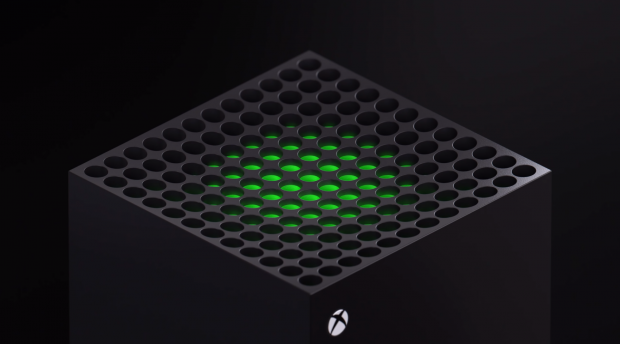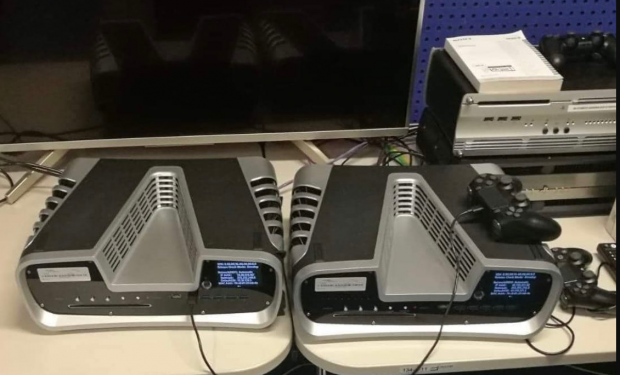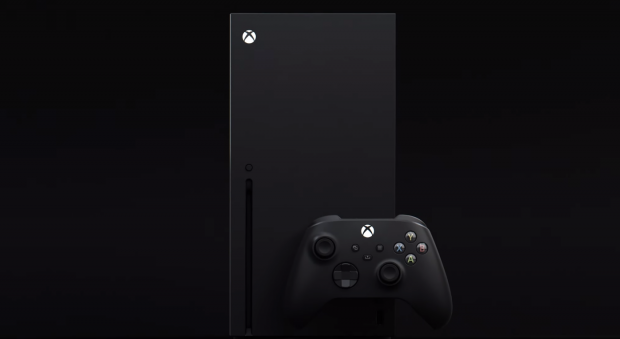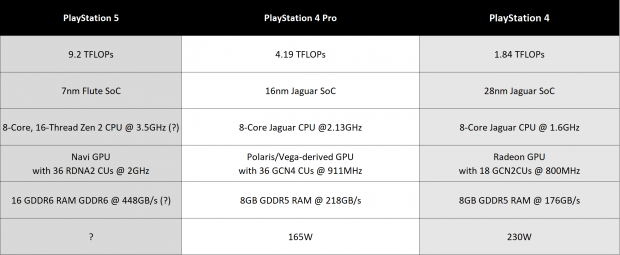New leaks show the Xbox Series X could be 33% more powerful than the PlayStation 5, with a sizable 55% leap in GPU compute units. But how many third-party devs will push this new monster-eating console to its limits? Will devs play it safe and bet on the PlayStation 5 instead?

Game developers will be very busy in 2020. This is especially true for third-party developer-publishers like Capcom, Ubisoft, Take-Two, EA, and Activision-Blizzard that all release multi-platform games. Assuming the reports are right, this year developers will have to make games playable on eight different Xbox and PlayStation consoles. It's all thanks to the new hybrid business model that merges the best things about the iterative console cycle like backward compatibility with a full-on next-gen reset, like substantially more powerful hardware.
But next-gen consoles won't instantly replace current-gen systems when they launch in 2020. The Xbox Series X and PlayStation 5 will be extensions of current-gen systems, just with better hardware. The PS4 and Xbox family will live alongside their next-gen forebears for years to come (Sony, for example, will sell the PS4 until 2022). For all intents and purposes it's a new familial hierarchy--just think of the Xbox SX and PS5 as the new step-fathers who slowly gain custody of the kids (in this case, the PS4 and Xbox One games library).
During this transition period both generations will have shared custody over games. This means games can (and likely will) release for two generations at a time. To maximize revenue, exposure, and sales, devs will need to make new games playable on last- and current-gen systems during the years-long transition period.
The eight consoles include five Xbox One consoles, and three PlayStation systems:
- Base Xbox One
- Xbox One S
- Xbox One X
- Xbox Lockhart (rumored but not confirmed)
- Xbox Series X.
- Base PlayStation 4
- PlayStation 4 Pro
- PlayStation 5
In essence, devs have to operate in three different time periods at once while making games: The past, or older-gen systems like the base PS4/Xbox One, the present, which incorporates the enhanced Xbox One S/X and PS4 Pro, and the future, which of course includes the PS5 and Xbox SX.

Sony's PlayStation 5 "Prospero" devkit.
Read Also: A $399 PlayStation 5 will conquer next-gen
Admittedly this process won't be extremely complicated for developers. The next-gen Xbox Series X uses the same Xbox software development kit that allows devs to make one game and scale it across Xbox platforms intuitively, as well as leverage potent and flexible APIs like DirectX. Microsoft also has some new tricks up their sleeves for next-gen systems.
Even still, it's a process that includes extra work, especially when developers want to pull the most out of the new Zen 2 CPUs and Navi GPUs housed in the PS5 and Xbox SX. The new APIs and frameworks will ease the workload, but the bulk of the trials come with experimentation, iteration, and finding new ways to creatively harness each consoles' power and capabilities. That's why Sony and Microsoft sent out devkits for this express purpose, to give devs a chance to practice and see what the system can do.
There's a marked discrepancy in hardware performance between the hardware generations, and we'll see that presented as a major marketing point in 2020 as developers do some amazing things with their creations.
Games will look better than before with ray tracing and native 4K resolution, they'll play better than ever thanks to new tricks like variable rate shading, which can tremendously boost frame rates, along with hardware synergies like customized SSDs working together with the new AMD SoC.
And by correlation, current-gen games will look worse than their flashy successors.

Read Also: PS5, Xbox Series X SSD may use software-defined flash to boost speeds
Not only that, but developers will have the chance to enhance older PS4 and Xbox One games to play better on the PS5 and Xbox Series X. This could be similar to the PS4 Pro and Xbox One X enhancement patches that added better performance and visuals like boosted frame rates, 4K textures, and smoother animations into base PS4 and Xbox One games.
The Xbox Series X was built from the ground up with backward compatibility in mind. The SoC was specifically designed to play four generations' worth of Xbox games--from OG Xbox, Xbox 360, and Xbox One to the new Xbox SX titles.
Microsoft's Phil Spencer also confirmed the new console will play these games better than any existing Xbox system, indicating that both native optimizations (like the PS4 Pro's Boost Mode) and developer-specific optimizations (Xbox One X Enhanced patches) will be included.
Sony's PlayStation 5 was likewise built with backward compatibility in mind. The PlayStation 5's GPU has three profiles that downscale performance to natively emulate both the PS4 and PS4 Pro, indicating that all existing PlayStation 4 games will be supported.
The PS5's GPU profiles include:
- Gen2 mode - Fully unlocks the Navi GPU at 2GHz for next-gen games
- Gen1 mode - Downscales the GPU to 911MHz, 218GB/sec bandwidth, and 64 ROPs to emulate the PS4 Pro
- Gen0 mode - Drops the GPU to 800MHz with 176GB/sec bandwidth and 32 ROPs to emulate the base PS4
Developers even say the PS5 is the easiest console to develop games on.

Read Also: Xbox Series X GPU is better than any Navi GPU released so far
The question here is if old games can be rigged to play like next-gen titles, complete with ray tracing, higher FPS, better draw distances, improved anti-aliasing, and of course, dramatically better loading times. We're betting some of these are off the table, but it presents massive potential to breathe new live into older games.
The most logical path for this is to simply remaster and re-release an old game on a new system. Maybe The Witcher 3 as an Xbox Series X remaster that harnesses the full brunt of the console's 12TFLOP GPU.
The real question now is how developers will use the hardware to make their titles. Will third-party developers care to eke out every drop of power from the PS5 and Xbox Series X? Will they have to compromise and make a kind of blanket version with slight optimizations and improvements between the two systems? Possibly, especially now they have so many choices like cross-gen releases and backward compatibility enhancements to consider.
Typically we see first-party devs maximize each systems' potential, and rightly so, given their proximity to the customuzed base silicon hardware and direct line to their parent companies. Its these game-makers that transform and the shape the console's hardware specs over time. We've seen first-party studios like Guerrilla Games push the base PS4 to amazing heights with Killzone Shadow Fall in 2013, and again in 2017 with Horizon Zero Dawn.
Microsoft's Turn10 studio enacted serious witchcraft by hitting native 4K 60FPS on the Xbox One X with 70% GPU usage in Forza 7. We've also seen The Coalition push some serious magic with Gears 5.
But what about third-party developers?
There's so many possibilities with next-gen systems and developers will have to compromise. Some things, like elaborate enhancement patches, will be put on the back burner. Others, like a forked release cadence across both gens, is a guaranteed money-maker.
That's not where all the choices end, though. Thanks to an imbalance of power, third-party devs can choose which console to emphasize with their games.
Reports say there's a sizable power difference between the PlayStation 5 and Xbox Series X.


Xbox Series X specifications compared to current-gen Xbox consoles (top), and the PlayStation 5 specs compared to PS4 systems (bottom).
Leaked specs from the Arden devkit affirm the Xbox SX has the GPU advantage with a 12 TFLOP Navi graphics processor with 56 RDNA 2 compute units clocked at 1.8GHz. Rumor also has it the Xbox SX's new 8-core, 16-thread Zen 2 CPU is clocked at 3.5GHz. All this hardware is wrapped in the flexible dev tools Microsoft has designed.
The PlayStation 5, on the other hand, apparently only has a 9.2TFLOP GPU with 36 RDNA 2 compute units (the same amount as the PS4 and PS4 Pro) and a possible clock of up to 2GHz. The PS5 likewise has an 8-core, 16-thread Zen 2 CPU, but no CPU clock speeds were outlined for the system. These numbers were also based on the PS5's Prospero devkit with its codenamed Oberon APU.
Microsoft might have the raw console power advantage, but Sony has the sales advantage, which is largely more important.
The PS4 currently has a 100 million-strong install base with many hundreds of millions of games attached to the milestone. Every PS4 owner has a collection of games--all of which will carry forward to the PlayStation 5.
By proxy and by virtue of PS4 backward compatibility, the PlayStation 5 will essentially ride the PS4's monumental wave of sales into a new generation. And since the PS5 might be weaker in terms of graphical horsepower, Sony could sell the PS5 at, say, $399 to completely conquer the new generation like it did starting in 2013.
This will be an important consideration for third-party developers. It may lead to developers prioritizing the PS5 because of the PS4's track record. Thanks to the innate BC capabilities, the PlayStation 5 will essentially be an extension of the PlayStation 4 generation.
Given this, we could see developers opt not to go overboard with their Xbox Series X games as to not undercut their PlayStation 5 versions. The idea is simple: They wouldn't want to jeopardize the performance of a game on a potentially better-selling system.
That being said, there's plenty of games that play and look tremendously better on the Xbox One X than they do on PS4 Pro thanks to the former's beefier 6 TFLOP GPU. That difference could be magnified further with next-gen systems.
The real question is whether or not devs want to make a spectacle of their games on the Xbox Series X, or create two great ports for both systems. It's a curious question with a not-so-clear answer, especially given the multitude of optimizations needed for last-gen, the backward compatibility/enhancement considerations, and new experimental hardware that won't fully mature until 1-2 years into its lifecycle.
The PlayStation 5 could be seen as the safer bet due to the PS4's success. I can't underline how much of an impact that full PS4 backward compatibility will have on PS5 sales. If the PS5's price is right, Sony will attract a huge portion of current PS4 owners and invite them to bring their collection of games right over.
In any case, we'll just have to wait until Holiday 2020 to see how it plays out.
Check below for a massive catalog on both next-gen consoles, including specifications and lots of coverage on the Xbox Series X and PlayStation 5.
Xbox Series X
Xbox Series X is due out by Holiday 2020. No pricing has been announced.
Check below for confirmed specs and details, and a huge content listing of everything we've heard about Xbox Series X so far:
Xbox Series X confirmed details (Formerly Project Scarlett):
- 8-core, 16-thread Zen 2 CPU
- Navi GPU on RDNA architecture
- Highly customized 7nm SoC from AMD
- GDDR6 memory
- 2x Xbox One X's 6TFLOPs of GPU perf
- 4x CPU power of Xbox One generation
- Can deliver up to 40x more performance than Xbox One in specific use cases
- Adaptive sync supported
- Super-fast SSD that can be used as VRAM
- Supports 8K resolution (likely media playback)
- 120FPS gaming
- Variable refresh rate (adaptive sync/FreeSync)
- Variable Rate Shading
- Raytracing confirmed with dedicated raytracing cores
- Backward compatible with thousands of Xbox, Xbox 360, and Xbox One games
- New controller with a dedicated share button
- Compatible with Xbox One accessories
Lockhart (Unconfirmed lower-end Xbox Series hardware)
- 1440p 60FPS
- No disc drive
- Super-fast SSD that can be used as VRAM
- 7nm AMD SoC w/ scaled-down 8-core, 16 thread Zen 2 CPU at 3.5GHZ and Navi GPU
- Lower GDDR6 memory pool (Possibly 12GB)
- ~6-8 TFLOPs of power?
- Aims to rival PS4 Pro/Replace Xbox One S
- Full backward compatibility with all Xbox One games
- Cheaper MSRP
Anaconda/Xbox Series X/Project Scarlett
- 4K 60FPS
- Disc drive with 4K UHD playback
- Super-fast SSD that can be used as VRAM
- 7nm AMD SoC with 8-core, 16 thread Zen 2 CPU at 3.5GHz and Navi GPU
- 16GB GDDR6 RAM
- 12 TFLOPs of power
- 2x GPU power as Xbox One X/aims to replace Xbox One X
- Full backward compatibility with all Xbox One games
- More expensive MSRP
Xbox Series X coverage:
- Xbox Series X will boost performance of previous gen Xbox games
- PS5, Xbox Series X SSD may use software-defined flash to boost speeds
- Microsoft to 'virtually eliminate' loading times on Xbox Series X
- How the Xbox Series X will look in your living room
- Clarifying the Xbox Series X name
- Xbox Series X's custom SoC built with backward compatibility in mind
- Next-gen Forza is playable on Xbox Series X, is 'vastly different'
- Xbox Series X size comparison vs Xbox One, PS4 Pro, Switch
- Next-gen Xbox controller has a share button
- Xbox Series X naming scheme leaves door open for Lockhart
- Xbox Series X may allow suspend and resume for multiple games at once
- Microsoft reveals next-gen Xbox console, the Xbox Series X
- Xbox Series X may allow suspend and resume for multiple games at once
- Next-gen Xbox Lockhart has 'significantly less RAM' for 1440p gaming
- Next-gen Xbox Scarlett specs: 12TFLOPs, 16GB RAM, 3.5GHz Zen 2 CPU
- Cheaper next-gen Xbox Lockhart targets 1440p 60FPS
- Cheaper next-gen Xbox Lockhart targets 1440p 60FPS
- Project Scarlett devkits aren't widely available yet
- PS5, Xbox Scarlett SSD may use Optane-like ReRAM to supercharge speeds
- NVIDIA G-Sync monitors to improve PlayStation 5 and Xbox Scarlett
- Project Scarlett won't get VR gaming, Microsoft doesn't care about VR
- Next-gen Xbox Scarlett plays four generations of Xbox games
- Microsoft teases next-gen Xbox: 8K, 120FPS, super-fast SSD
- Xbox Scarlett CPU: 'no compromises', allows for 4K 120FPS gaming
- Microsoft: Xbox Scarlett will kick PlayStation 5's ass in perf/price
- Next-gen Xbox may hit 4K 60FPS in every game
- Project Scarlett to hit 1080p 120FPS gaming
- Project Scarlett trade-in program announced, but there's a big catch
- New Viking Assassin's Creed may be next-gen console launch game
- Next-gen Xbox may get room-scale VR gaming
- PS5 and Xbox Scarlett will both handle ray tracing differently
- Gears 5 developer says Xbox Scarlett has dedicated ray tracing cores
- GTA 6 on PS5, Project Scarlett to have insane hyper-realistic visuals
- AMD 'Flute': Xbox Scarlett SoC: Zen 2 8C/16T @ 3.2GHz on 7nm
- Project Scarlett's price isn't locked in yet
- Project Scarlett isn't the last Xbox console
PlayStation 5
Sony is expected to reveal the PS5 in a special event in February 2020. The console will release in Holiday 2020, and it may cost $499.
Check below for more info:
PlayStation 5 specs and details:
- Custom SoC with second-gen Navi GPU, Zen 2 CPU
- 8-Core, 16-thread Zen 2 CPU at 3.2GHz
- Navi GPU at 2.0GHz with 36 Compute Units
- Navi, Zen SoC uses new AMD RDNA 2.0 architecture
- Ultra-fast SSD
- Support for 4K 120 Hz TVs
- Ray-tracing enabled
- 8K output support (for gaming)
- Plays all PS4 games
- Separate games that ship on BD-XL Blu-ray discs
- New controller with extensive haptic and tactile feedback
PlayStation 5 Coverage:
- PS5, Xbox Series X SSD may use software-defined flash to boost speeds
- PS5's SSD is 'exceptionally powerful,' may beat Xbox Series X speeds
- DualShock 5 renders show new trigger design, USB-C, ergonomic shell
- PlayStation 5 to support 8K gaming, Sony confirms
- New PlayStation 5 renders show off radical different design, again
- Leaked PlayStation 5 ad prices console at $1,000, is totally fake
- Sony seeks a new Head of Strategy for Worldwide Studios
- Leaked PlayStation 5 devkit photos show new DualShock controller
- PS5, Xbox Scarlett SSD may use Optane-like ReRAM to supercharge speeds
- NVIDIA G-Sync monitors to improve PlayStation 5 and Xbox Scarlett
- PlayStation 5: Everything We Know So Far
- PlayStation 5 confirmed to have 8C/16T Zen 2 CPU from AMD
- PS5, Project Scarlett may use Samsung's 6th gen V-NAND NVMe SSDs
- PS5 backward compatibility confirmed, will play PS4 games
- Sony's next-gen PlayStation 5 has 4K 120Hz output support
- PS5, Project Scarlett to hit over 10TFLOPs of power, sources say
- PS4 will be supported into 2022, to live alongside PS5
- Sony: ultra-high-speed SSD is 'the key' to next-gen PS5
- PS5 dev kit rumor: 'ultra-fast RAM', Navi GPU with 13 TFLOPs
- PlayStation 5 rumored to ship with 2TB of super-fast SSD for $499
- Insider: PlayStation 5 dev kit faster than Xbox Scarlett right now
- PS5 cartridges aren't real, patents are for Sony kids toys
- PS5's SSD may benefit PS4 games the most
- PS5 powered by Navi in 2020, AMD making Navi with Sony input
- Cloud-powered PlayStation controller may let you play free game demos
- Gran Turismo 7 is a PlayStation 5 launch title: launches Nov 20, 2020
- PS5 confirmed to support 8K video, ray tracing, all on Navi
- PlayStation 5 rumored to cost $499, launches November 20, 2020
- PlayStation game demos are coming back with Sony's ambitious new plan
- PS5 controller: Built-in mic, USB-C, no lightbar, ergonomic design
- PlayStation 5 concept video shows totally new design
- Sony solves PS5's biggest issue
- Sony: PS5 development going according to plan
- New Viking Assassin's Creed may be next-gen console launch game
- AMD working on 'secret sauce' for next-gen Xbox/PlayStation
- The first real photo of a PlayStation 5 dev kit appears
- Next-gen PS5/Xbox Scarlett open-world game: 'best real-time graphics'
- Sony restructures workforce to prepare for PS5
- PlayStation VR 2: built-in cameras, wireless, ready for PS5
- PS5 games will ship on 100GB Blu-ray BDXL discs
- PS5 and Xbox Scarlett will both handle ray tracing differently
- PlayStation 5 could feature AI-powered 'PlayStation Assist'
- Sony won't abandon singleplayer story-driven games on PS5
- PS5 rumor: GPU is nearly as powerful as RTX 2080, GPU clocked at 2GHz
- PlayStation 5 rumored to be unveiled on February 12, 2020
- Sony to raise PS5 cost thanks to U.S. tariffs


